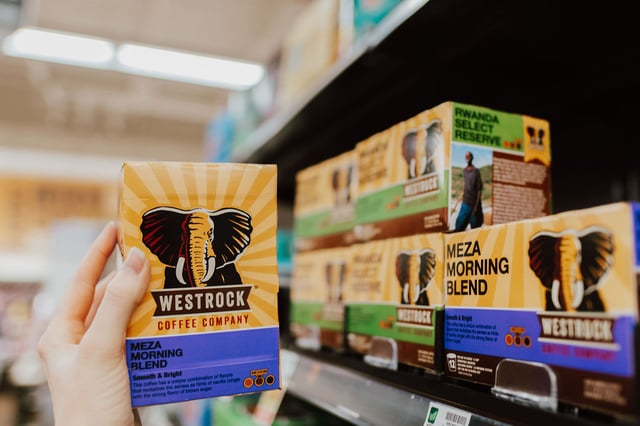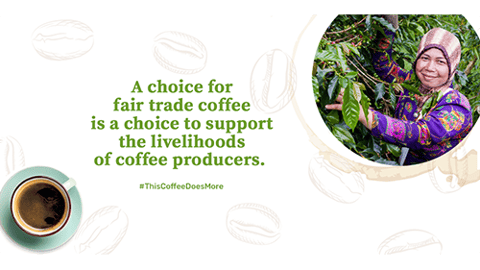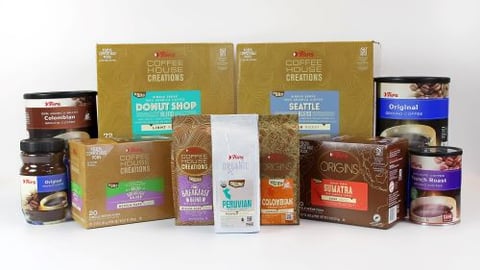The Coffee Sector Reflects Marketplace Trends
If coffee is fuel for people to get through the day, the grocery store is a busy pit stop. Whether shoppers are picking up supplies to brew coffee drinks at home or ordering a cup of joe to go, they can choose from an ever-growing array of options in the center store and foodservice-at-retail perimeter as grocers keep up with the latest habits and preferences.
As in other categories, the broader coffee sector reflects marketplace trends, including demand for better-for-you and fortified products, and an overall desire for sustainably harvested and produced items. Flavors run the gamut from mild to dark and other tastes in between, as consumers seek personally satisfying beverage experiences. Also, convenience, while taking on different dimensions during a pandemic that changed the way people work and live, is a factor in product development and grocery assortment.
Solutions for the “Better”
With more shoppers seeking better-for-you and better-for-the-planet consumable products, coffee CPGs and grocers are delivering on those twin demands.
For example, interest in enhanced beverages for health, wellness and, in the wake of the pandemic, immunity, are spurring the rollout of coffee products that fit that profile. The Super Coffee brand, for example, offers items like a ground dark roast enhanced with antioxidants, vitamins and I-theanine. VitaCup makes a Slim coffee enhanced with garcinia, ginseng and B vitamins, and a keto-friendly Genius coffee fortified with MCT oil, turmeric and B vitamins deemed helpful for brain health.
Although coffee made from beans is inherently plant-based, some coffee makers are adding other or different plant-based ingredients. For instance, Laird Superfood offers a line of functional coffees made from mushrooms, like its Focus medium roast made with mushroom extracts and botanical adaptogens, and its Boost variety, also made with mushroom extracts and botanicals, along with added vitamin D.
In addition to varieties that appeal to wellness-minded consumers who want some kind of “plus” in their coffee drinks, retailers’ coffee shelves are lined with more products that fall under the responsibility umbrella. From an environmental perspective, although sustainably sourced and organic coffees aren’t new, there are more of them, from brands like Ethical Bean Coffee, Chameleon Organic, Meritage Coffee, Mount Hagen and Newman’s Own, to name just a few. Often, the packaging aligns with the mission: Mount Hagen coffees, for example, are sold in a recyclable glass jar and single-serve sticks.
A new entry in the field is Atomo Coffee, the first molecular coffee company on the market, with a cold-brew ready-to-drink coffee made in a way that results in 93% less carbon emission and 94% less water than traditional coffee. Produced without coffee beans and using upcycled ingredients, Atomo’s product line includes a classic dark roast and an ultra-smooth roast.
Fair trade coffees, which also tend to be organic or made in a sustainable way, are another way for grocers to add responsibly sourced SKUs at a time when more shoppers are seeking information about the products they buy. The CVS chain, for example, has added Fair Trade Certified coffees to its Gold Emblem grocery brand, with sales benefiting coffee producers through community development funds.
Westrock Coffee Co. LLC is an example of a brand that follows the wider definition of responsibility, recently pledging to responsibly source 100% of its coffee and tea by 2025. The Little Rock, Ark.-based company started as a small exporting business in Rwanda, establishing sustainable and traceable supply chains in East Africa, and has grown to produce 173 million pounds of coffee and tea around the world.
The 2021 Best Coffee Cities in America
WalletHub compared the 100 largest cities across 12 key indicators of a strong coffee culture. The data set ranges from coffee shops, coffee houses and cafés per capita to the average price per pack of coffee.
Top 20 Cities for Coffee Lovers
- Portland, Ore.
- San Francisco, Calif.
- Seattle, Wash.
- Orlando, Fla.
- Pittsburgh, Pa.
- Honolulu, Hi.
- Tampa, Fla.
- Miami, Fla.
- San Diego, Calif.
- Boston Mass.
- Minneapolis, Minn.
- Los Angeles, Calif.
- Denver, Colo.
- Long Beach, Calif.
- New Orleans, La.
- Oakland, Calif.
- Jersey City, N.J.
- Washington, D.C.
- Irvine, Calif.
- New York, N.Y.
Source: WalletHub
“The better-for-you designation sometimes refers to organic, but our definition of better-for-you entails being better for the producers of the coffee, better for the environment and how it’s produced, and better in terms of quality,” explains Matt Smith, Westrock’s EVP of global supply chain, quality and sustainability. “We are seeing excellent demand growth in these areas.”
Westrock is also seeing a bump for its private label coffees and teas among grocers. “I think we’ll see that demand accelerate, especially because the upcharge of better-for-you is very minimal in terms of the brand protection it provides,” Smith notes.
In addition to embracing responsibly sourced coffee products from international producers, grocers – especially smaller and independent stores – often differentiate themselves by carrying coffees from local manufacturers. E-commerce businesses have delved into this area, too; FreshDirect, for example, recently added premium coffee from a local Bronx, N.Y., brand, Don Carvajal Café.
Choices for Convenience
Retailers can also provide solutions for their coffee-drinking consumers by offering convenience-oriented products, increasingly with a premium profile.
Ready-to-drink (RTD) coffee products appeal to shoppers who want a quick pick-me-up or don’t feel like making their own coffee beverages at home. Shelf-stable products in bottles and cartons have been effectively merchandised alongside whole-bean and ground coffee in the coffee aisle, and cross-merchandised in grab-and-go refrigerated cases closer to checkout areas and in the foodservice perimeter.
In addition to traditional RTD coffee products like iced coffee, flavored brews and espresso-inspired drinks, this slice of the market has seen some newer entries with functional properties. One example is Soylent’s Café Mocha, made with plant protein.
One of the original convenient forms of coffee, of course, is instant coffee. Although some instant-coffee mainstays have retained loyal followings, there has been a premiumization of instant coffee over the past several years. Following its Via instant-coffee packs, for example, the Starbucks grocery brand added a premium instant-coffee product, made with 100% arabica beans. Meanwhile, the venerable Nescafé instant-coffee brand continues to expand its line, with new higher-end varieties like Clasico Brazil Instant Coffee.
As cold brew has taken off, so have instant and near-instant cold brew products. Examples include a cold-brew coffee pack from Dunkin’s grocery brand, and cold-brew concentrates from manufacturers like Chamaeleon Organic and Starbucks.
At Westrock, Smith agrees that convenience, while evolving in the face of the pandemic, is a strong sales driver. “We continue to see growth and a focus on single-serve and ready-to-serve product lines, including cold brew,” he says. “Convenience and convenience at home are growing trends – these things will be part of grocery shelves in the future.”
Despite some concerns in recent years about package waste, convenient coffee pods and capsules also take up a good part of the center store coffee area. In addition to new roasts and flavor varieties from brands that offer such products, this segment includes pods considered eco-friendlier, like Gourmesso’s 100% compostable pods and capsules, carried by retailers such as Walmart and Amazon.
Providing for Palates
Grocers can cater to consumers’ taste for rich, robust flavor – evident in other product categories like chocolate and beer – by offering darker and fuller-bodied varieties of coffee beans, grinds, pods, capsules and instant-coffee products. Longtime brand Folgers, for its part, offers Noir and Black Silk lines for consumers who gravitate toward dark-roasted, complex coffees; these varieties come in ground coffee, pod and single-serve stick formats. Another brand specializing in dark coffee is Death Wish Coffee, which touts its Arabica and Robusta bean blend as “the world’s strongest coffee,” with twice the strength of the average cup.
On the other end of the spectrum, grocers can also meet the preferences of coffee consumers who want or need something less bold. Folgers, for instance, offers smooth coffee options described as “stomach friendly,” targeted to those who like coffee but want to drink something mild and gentle.
In this pumpkin spice latte season that has given rise to the culturally hip “PSL” acronym, seasonal coffee varieties and displays can draw in shoppers who get excited about limited-time offerings, The Starbucks grocery brand, for its part, expanded its fall-themed retail offerings this year, supporting the line with point-of-sale signage and materials.
Heading into the holidays, end caps and other displays with seasonal flavors of coffees can grab the attention of consumers who have begun entertaining family and small groups of friends, following a mostly at-home 2020 holiday.
Meanwhile, aligning with the “never bored” mantra when it comes to adventurous flavor and today’s consumers, coffee brands continue to experiment with different flavor combinations to give a fresh jolt to the category. Case in point: Dunkin’s recently introduced ground coffee additions of Caramel Me Crazy, Cinnamania and Chocoholic Pancake.
If You Brew it, They Will Come
Even with the pivots of the COVID-19 era, the in-store coffee bar remains a shopper attraction and a way to get traffic in the door. Many retailers, especially larger operations with multiple banners, partner with coffee chains like Starbucks to provide coffee service inside their brick-and-mortar locations.
There are also opportunities to work with local or regional coffee stores to create a café-within-a-store. For instance, Homeland Stores, part of HAC Inc. in Oklahoma City, Okla., recently opened a new location that includes a coffee shop run by Not Your Average Joe, an organization that provides employment to intellectually disabled individuals.
Grocers around the country are raising their own bars when it comes to coffee menus. In one of its newest stores in the New York City area, for example, Whole Foods Market unveiled a full-service coffee bar, complete with nitro cold brew on tap.
The espresso bar is a place where smaller and independent grocers can shine. Greer’s, a specialty market in Alabama, recently opened a new location with a coffee station and a rooftop patio where shoppers can enjoy their drinks.
Since opening last June, The Brew bar at Dom’s Kitchen and market in Chicago, has become a neighborhood hub, where people can pick up coffee and tea in the morning, and wine, beer, seltzers and cocktails in the evening. The area includes an exterior walkup window where customers can pick up online orders.
“The Brew, Dom’s adjacent greenhouse and two outdoor patios have become popular hangout spots for locals,” notes spokeswoman Megan Jennett, adding that the section is also home to informal chess nights every other Friday, and has become a gathering spot for a local running club.
The store has also maximized coffee-merchandising opportunities. “One of the great things about Dom’s is that everything that is in our kitchen is also in our market,” Jennett explains. “We sell the beans that we use behind The Brew in the market. Recently, we partnered with Hexe Coffee Co., a local coffee roaster and café and brand that we serve behind The Brew, to bring whiskey barrel-aged beans to Dom’s. Hexe brought the whole barrel to Dom’s, cracked it and scooped out beans for guests to purchase and bring home.”
Some industry suppliers are making it easier for grocers to get started in coffee service. For instance, Berkeley, Calif.-based Bellwether Coffee has created a self-contained coffee-roasting machine that is all-electric, ventless, smokeless and automated, and can roast up to 200 pounds a day, to use in an in-store café or as a store brand in the coffee aisle. The roaster is intended to provide an in-store coffee experience for shoppers, both from an aroma and taste standpoint.







